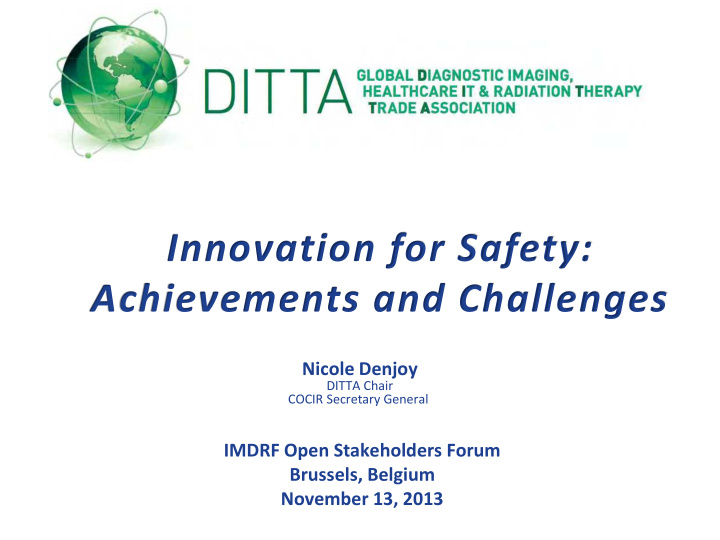



Innovation for Safety: Achievements and Challenges Nicole Denjoy DITTA Chair COCIR Secretary General IMDRF Open Stakeholders Forum Brussels, Belgium November 13, 2013
DITTA - the Global Diagnostic Imaging, Healthcare IT, and Radiation Therapy Trade Association • DITTA is a global organization representing industry associations of manufacturers around the world • DITTA, a non-profit trade association, has represented this industry for more than 12 years
DITTA - the Global Diagnostic Imaging, Healthcare IT, and Radiation Therapy Trade Association Member companies manufacture: • medical x-ray equipment • computed tomography (CT) scanners • ultrasound • radiation therapy equipment • nuclear imaging • magnetic resonance imaging (MRI) • medical software • imaging information systems • health IT • radiopharmaceuticals
Examples of Innovation Diagnostics Biotech & Genomics IT & bioengineering • Faster, accurate imaging • Targeted therapy • eHealth/Telemedicine • Molecular imaging • Proteomics/DNA • Mobile solutions • Miniaturisation/portability • Biomarkers • BioSensors • Point of Care diagnostics • Rapid screening tools • Computer Aided Diagnostics • Therapy selection/monitor • Vaccine development • Patient monitoring
Example: Imaging in Breast Cancer Diagnosis of Recurrence Detection of Residual Disease PET/CT New markers Therapy Evaluation Mammography In-vitro test Therapy Selection F-Angiogenesis PET Staging CTMRI Radiation Treatment Diagnosis Optical Functional Marker Screening PET/CT Microarray Predisposition Functional PACS marker Microarray Electronic Health Record CT Proteomics Medication Management MR Mammography PET/CT Exist Today Genomics Ultrasound Nuclear Med BRCA 1,2 MR Emerging Research and Risk Profiling Technologies 5
Product Lifecycle: Continuous Improvement Stakeholders are key in providing input on safety: patients, HCPs, regulators, CIOs, etc. Concept Prototype Clinical Manufacture Commercialize End of Life • User Needs Postmarket Stakeholder • Design Input/Output • Verification • Validation State-of-art international standards are the foundation to the full product lifecycle Milestones for Patient Safety focus
Challenges • Lack of: • Harmonized regulatory framework Regulatory • Internationally recognized standards Framework • Common data set for product registration • Common process for postmarket requirements • Impact on time to market (in all geographies) Patient Access • Access to clinical solutions • Quality of care • Increase of: • Integrated care • HomeHealth Societal • Aging populations Trends • Non-communicable chronic disease • Patient empowerment • Demands for healthcare
An Example Solution – CT Dose • Goal – CT dose optimization • Stakeholders – patients, physicists, Joint Task Forces healthcare professionals, equipment designers and manufacturers, regulators, hospital managers, etc. • Analyze problem, identify potential root causes, develop solutions Commitments • Implement dose optimization measures , e.g., in standards • Establish dose management, recording and reporting • Provide extensive multimedia training curricula • As technology progresses, CT manufacturers provide Adoption clinical image quality at lower doses • Continued investment in dose reduction without compromising diagnostic accuracy Innovation • Expand model to other modalities
Future Trends • Demand for rapid development of telehealth, mobile health, cloud computing, remote care, etc. Health IT • Protecting patient data and cybersecurity • Software as a medical device Integrated • Integrated technologies (product and Technologies services) to cover the continuum of care • Local manufacturing (regulatory pressure, cost of labor, proximity to resources and raw materials) Global • Increasingly complex, global supply chain Manufacturing • Ancillary regulation compliance (recycling, transportation of used parts/waste) Health Tech. • Building clinical and socio-economic evidence Assessment for innovative technologies
Processes and Communication Supporting Safety • Industry, healthcare professionals (HCPs) and patients Training • Technology and intended use • In person, on site, and on-line • Ongoing support for HCPs/patients Technical Support • Preventive maintenance programs • Remote diagnostics and upgrades • Product upgrades Improvements • Preventive and corrective actions • In person, letters, on-line alerts Safety Alerts • Regulator consultation • Adverse event reporting, recalls
Recommendations to Stakeholders 1. Further harmonize the global regulatory framework 2. Continue promoting active partnering with all stakeholders in the implementation of innovative and safe technologies 3. Increase awareness through shared responsibility in providing effective education
Innovation for Safety: Achievements and Challenges The Way Forward THANK YOU !
Recommend
More recommend